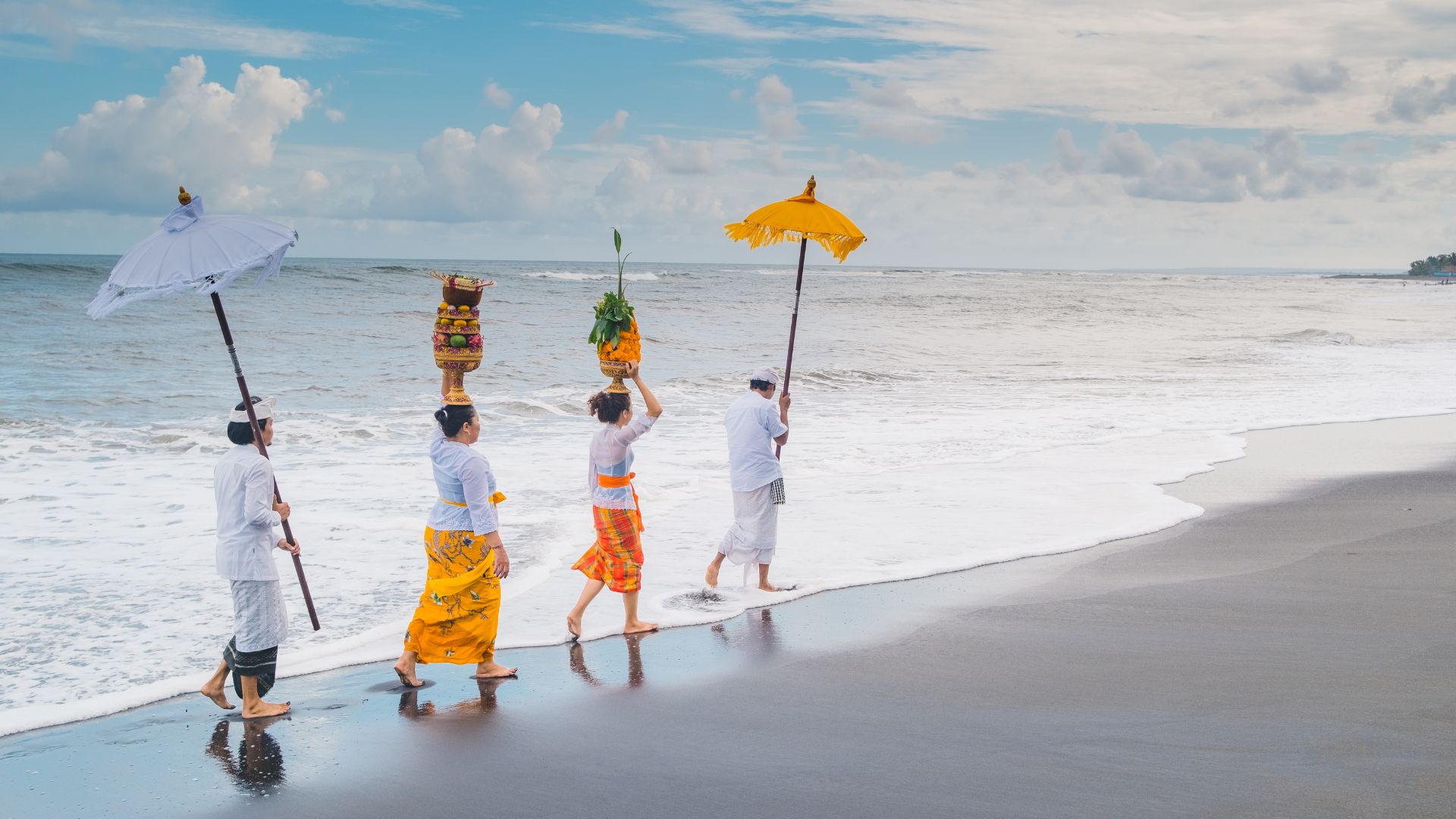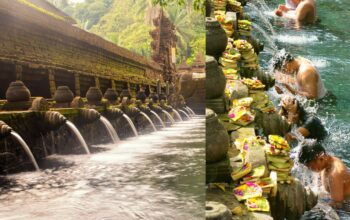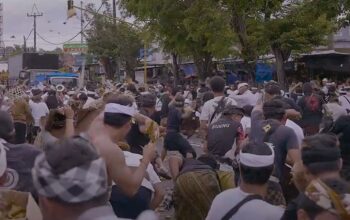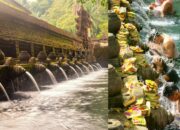If you’ve ever traveled to Bali leading up to the Nyepi holiday, you might have seen thousands of people in traditional attire carrying offerings, yellow umbrellas, and Barong, walking towards the beach or water sources. This is the Melasti tradition, a significant ritual in Balinese Hindu culture, rich with meaning and spiritual value.
What is the Melasti Tradition in Bali?
Melasti is a sacred ceremony performed by Balinese Hindus as part of the preparations for the Nyepi holiday. This ceremony is usually conducted en masse, where devotees from various traditional villages (banjar) bring sacred symbols from temples to the sea, lakes, or other water sources to be purified. During Melasti, it’s not just sacred objects that are “bathed,” but it’s also a moment for self-purification, both physically and spiritually. Essentially, Melasti is like a “soul cleansing” to be purer and ready to welcome the new year according to the Saka calendar.
When is the Melasti Tradition Performed?
The timing of Melasti usually takes place a few days before Nyepi, depending on the village and their respective customs. Generally, you can witness Melasti around 3-5 days before Nyepi. This period is believed to be an auspicious time to cleanse the universe of accumulated negative energies. The ceremony is typically held in the morning. Balinese Hindus will walk (sometimes quite a distance) while carrying all the ceremonial equipment towards the sea or lake with great enthusiasm and solemnity.
What is the Purpose of the Melasti Ceremony?
The main purpose of Melasti is to purify the “pralingga” or sacred symbols of the Deities and Bhatara present in the temples, as well as to purify oneself from all physical and spiritual impurities. Additionally, Melasti is also considered a form of universal cleansing. All negative elements such as hatred, greed, anger, and others are symbolically cast into the sea so they do not carry over into the upcoming Saka new year. Therefore, Melasti is not merely a ritual but also an important reminder for self-introspection.
What is the Spiritual Meaning of Melasti for Balinese Hindus?
Spiritually, Melasti holds a very deep meaning. Balinese Hindus believe that humans must not only maintain physical cleanliness but also purity of mind and heart. Through the Melasti ceremony, they are invited to reflect, release ego, and seek forgiveness for all mistakes committed, whether intentionally or unintentionally. The sea or water here symbolizes the source of life and purification. By casting negative symbols into the water, devotees hope to start a new, cleaner, and more harmonious chapter, both with fellow humans, nature, and God.
Why is Melasti Performed at the Sea or Sacred Water Sources?
For the Balinese Hindu community, water is a symbol of purification. In Balinese Hindu belief, the sea, lakes, or other water sources are considered sacred places that can “cleanse” both physically and spiritually. The sea is chosen because it is believed to be capable of containing and dissolving all impurities and negative energies. When sacred symbols are brought to the sea and purified, it means that Hindus also surrender all bad things and hope to start a cleaner and more peaceful life. So, it’s not just because of the beautiful scenery; the sea plays a crucial role in this purification process.
How Does the Melasti Ceremony Procession Take Place?
The Melasti procession is usually carried out with great enthusiasm and solemnity. From early morning, residents from various banjars will gather in full traditional attire. Men and women carry ceremonial equipment, offerings, Barong, yellow umbrellas, and most importantly—the pralingga or sacred symbols from their temples. The procession will walk or use vehicles (if the distance is far) towards the designated sea or water source. Along the way, the atmosphere is very solemn, sometimes accompanied by gamelan music or sacred chants. Upon reaching the edge of the sea or lake, the ceremony begins. Prayers are offered by the pemangku (ceremony leaders), and the pralingga are purified with holy water. The devotees also pray together, asking for themselves and the entire universe to be cleansed of negative energies.
What Are the Stages in the Melasti Ceremony?
Generally, the following are the common stages in Melasti:
- Preparation at the Temple: Before departing, devotees hold a small ceremony at the temple to ask for safety during the journey and the ceremony. The pralingga or sacred objects from the temple are decorated and prepared with offerings.
- Procession to the Sea or Lake: The entire group then walks together towards the sea or lake. This is also called Mepamit, which is a spiritual permission to move to another place for purification.
- Purification Ceremony at the Sea: Upon arrival, the main procession takes place: purifying sacred objects with seawater, and communal prayers. Water here is considered a natural cleansing medium capable of neutralizing impurities.
- Release of Negative Energy: Sometimes, special symbols or offerings are cast into the sea as a symbol of discarding negative traits such as greed, anger, and resentment.
- Return to the Temple: After everything is finished, the devotees return to the temple in a calmer and more peaceful state. There is usually a closing prayer as a sign of the end of the procession.
Who is Involved in the Melasti Ceremony?
All Hindu residents of the village usually participate. Not only the pemangku or elderly people, but children, teenagers, housewives, fathers—everyone participates together in the ceremony.
- Pemangku or Hindu priests: They lead the prayers and the main procession. They also purify the sacred symbols with sea water or holy water.
- Banjar (traditional village) residents: They carry the offerings, yellow umbrellas, Barong, and sacred objects from the temple.
- Youths (pemuda and pemudi): They usually help carry equipment, organize the procession, or even play traditional music (gamelan) during the ceremony.
This ceremony also serves as an event for communal work and togetherness in the village. It’s no wonder the atmosphere feels warm and full of spirit.
What Equipment is Used in the Melasti Ceremony?
Since Melasti is a large and sacred ceremony, the equipment is abundant and full of meaning. Some of them include:
- Pralingga or pratima: These are sacred symbols from the temple, usually carried on a palanquin and covered with special cloth.
- Offerings (banten): Various offerings of flowers, fruits, and cakes beautifully arranged as a sign of devotion to the gods.
- Yellow umbrellas, tedung, and banners: Symbols of protection and honor for the gods and ancestral spirits.
- Barong or Rangda: Sometimes also brought along, as a complement and a symbol of protection from evil spirits.
- Gamelan: Traditional Balinese music that accompanies the procession, making the ceremony more vibrant and sacred.
All this equipment is carried together to the sea or lake, then purified through special prayers.
What is the Difference Between Melasti in Coastal Villages and Mountain Villages?
This is interesting. Bali has diverse geographical conditions. Not all villages are near the coast. So… how is Melasti performed if the location is far from the sea?
In Coastal Villages
Villages near the beach usually go directly to the sea for Melasti. They walk together or use vehicles to the nearest beach, then perform the entire procession there. The atmosphere is often more lively because many devotees from various villages gather in one place. The waves and sounds of nature become part of the ceremony.
In Mountain or Inland Villages
What if it’s far from the beach? Don’t worry, Melasti can still be performed. Devotees in mountain villages usually perform the ceremony at lakes, rivers, or sacred springs that are considered sources of life water (Tirta Amerta). Although the location is different, the purpose remains the same: to purify sacred symbols and oneself spiritually. The only difference is the location, but the essence of Melasti—namely cleansing and purification—is well-maintained wherever it is performed.
Conclusion
Therefore, Melasti is not just a visually beautiful tradition but also reflects the unity and spirituality of the Balinese community. From children to the elderly, from villages on the coast to those on the mountain slopes, everyone has their own way of welcoming Nyepi with a clean heart. If you happen to be on vacation in Bali before Nyepi, take the time to witness the Melasti ceremony. Who knows, it might be an experience that makes you fall even more in love with Balinese culture.












